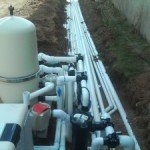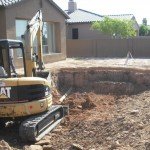Problems In Pool Construction
Arizona Landscaping, Blog, Phoenix Pools
4 Common Pool Building Mistakes and How-To Avoid Them
Unique talks to customers about the importance of accounting for crucial pool building components such as correct elevation, soil and plumbing and the cost-benefits of taking preventative steps to ensure a long-lasting, problem-free pool.
 1. Improper soil
1. Improper soil
The problem: Soil testing can be an expensive and extensive step, so it’s tempting for builders to skip it in fear that the added time and cost will turn away customers. The majority of pool builders put a clause in their contracts stating that homeowners are responsible for the soil condition on site. However, the risks involved with not obtaining soil information should not be taken lightly. The pool might crack, float out of the ground or migrate down a slope. It might leak and flood the home or a neighbor’s yard. Fixing the problem can mean virtually ripping the whole thing out and rebuilding it—an expensive and decidedly unpleasant set of measures.
The solution: Don’t take shortcuts. After the pool is excavated, test the dirt using a soil analysis professional, even if it means higher costs.
 2. Poor plumbing
2. Poor plumbing
The problem: Problems include improper pump sizing, improper number and placement of skimmers, and faulty sizing and placement of pipes. National consensus standards for pool construction did not exist until 1991, when the American National Standards Institute (ANSI) first approved standards developed by APSP. That means that over the past 40 years, builders and owners were mixing and matching various building standards. The effects of improper plumbing include poor water circulation and filtration, which can lead to problems such as high electrical and chemical costs and water discoloration.
The solution: Educate yourself on the industry standards for pool hydraulics.
3. Oversized pumps
The problem: A common hydraulics issue is caused by the myth that a bigger pump means a better pump. Oversized pumps can cause a number of problems, including noise, friction losses, wear and tear on pipes and pool equipment, high electrical costs and a short pump life. Pump replacement can cost pool owners up to $700. Unbalanced hydraulics means not only cost of replacing the pump, but wasted energy and money, poor water quality, and even physical danger, such as drain entrapment.
The Solution: Don’t choose a 2-horsepower pump when a 1-horsepower will do. Choosing the right size pump allows for better energy efficiency and overall pool cleanliness.
 4. Improper elevation
4. Improper elevation
The problem: Not properly setting elevation before building a pool can lead to dramatic drainage problems and add to the overall cost of pool maintenance. Most homes are built so that water drains toward the street. If not properly accounted for, pools will drain toward the house, which can cause flooding or erosion.
The solution: How high to set a pool depends on various factors including the slope of the pool site, existing drainage patterns and existing structures or elements surrounding the pool. One solution is to build a pool with raised bond beams, which by nature has a sophisticated drainage system. Building a pool where one end is deeper addresses any drainage problems that can be caused by improper elevation.